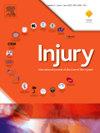Baseline predictors of depression and post-traumatic stress disorder (PTSD) symptoms in hospitalised adult burn survivors: A longitudinal, prospective cohort study
IF 2.2
3区 医学
Q3 CRITICAL CARE MEDICINE
Injury-International Journal of the Care of the Injured
Pub Date : 2025-01-22
DOI:10.1016/j.injury.2025.112151
引用次数: 0
Abstract
Background
Depression and post-traumatic stress disorder (PTSD) are becoming more prevalent among post-burn populations. With the increase in awareness of the significance of psychosocial injury adjustment for holistic health-related quality of life, beyond just physical, occupational, and functional recovery. However, the incidence of depression and PTSD in the adult population is inconsistent across published studies. To describe the baseline predictors of depression and post-traumatic stress disorder (PTSD) symptoms in hospitalised adult burn survivors over the first 12 months post-burn.
Method
A total of 274 participants, aged 18 years or over, with burn injuries, were hospitalized and treated at a tertiary burns centre in Queensland, Australia between October 2015 and December 2017. Additional follow-up data collected at 3-, 6- and 12-months post-burn injury. Dataset was analysed using gamma generalized mixed effects modelling techniques to assess the predictors of depression (PHQ-9) and PTSD (PCL-C) symptoms over time. Baseline predictors from personal, environmental, burn injury and burn treatment factors were assessed.
Results
Both mental health outcomes followed a similar trend, with the largest decrease in symptom severity occurring between 3- and 6-months. A smaller decrease then occurred between 6- and 12-months. The baseline predictors of depression and PTSD symptoms post-burn in adults varied, however, the common predictors were increased age, a pre-injury mental health diagnosis and financial insufficiency. In addition to these predictors, intentional injury and recreational drug use were also statistically significant predictors of increased PTSD symptoms, while previous trauma exposure, longer hospital length of stay (LOS) and, surprisingly, stable housing status were also predictors of higher PHQ-9 depression scores. All predictors included in the final models were statistically significant with a p-value < 0.10.
Conclusion
Overall, mental health symptoms in burns survivors generally improved over the 12 months of follow-up, with the largest improvement noted between 3 and 6 months. Age, pre-injury mental health diagnosis and insufficient financial status, however, were all found to be associated with poorer mental health outcomes over the first 12 months post-burn.
求助全文
约1分钟内获得全文
求助全文
来源期刊
CiteScore
4.00
自引率
8.00%
发文量
699
审稿时长
96 days
期刊介绍:
Injury was founded in 1969 and is an international journal dealing with all aspects of trauma care and accident surgery. Our primary aim is to facilitate the exchange of ideas, techniques and information among all members of the trauma team.

 求助内容:
求助内容: 应助结果提醒方式:
应助结果提醒方式:


